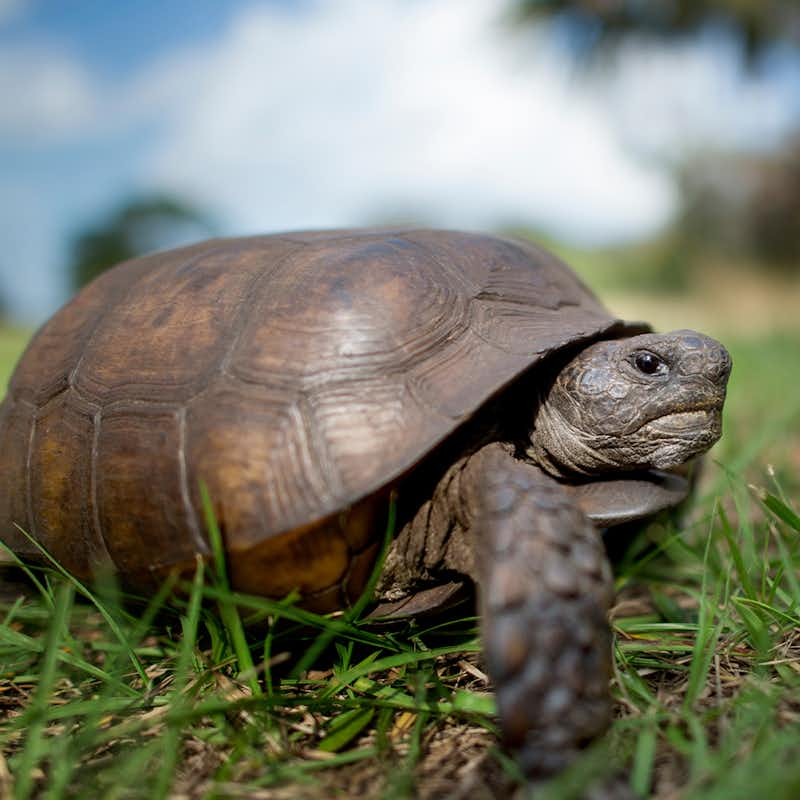Save the Gopher Tortoise
8,463 signatures toward our 30,000 Goal
Sponsor: The Animal Rescue Site
The Gopher tortoise is rapidly disappearing due to habitat loss from human development, agriculture, climate change, and more. Take action!

The Gopher tortoise, a species native to the southeastern United States, is facing a dire situation as its habitat is rapidly disappearing. This species has been a crucial part of the ecosystem for millions of years, but due to human development, agriculture, climate change, invasive species, and other factors, the Gopher tortoise population has declined dramatically and many argue that the species should be placed on the Endangered Species List by the U.S. Fish and Wildlife Service (FWS)1.
The situation has become so dire that environmental groups are now taking legal action against the FWS for not including the Gopher tortoise on the endangered species list in four southern states2.
The Gopher tortoise has a rich history in the United States. These tortoises were once found in more than 92 million acres of land in the southeastern U.S., stretching from eastern Louisiana to the Atlantic coast. The species has been around for millions of years and is considered a keystone species in the longleaf pine ecosystem3. Gopher tortoises have an important role in maintaining the habitat by creating burrows, which are used by many other species. These burrows also help prevent wildfires by creating firebreaks, and they provide shelter and refuge for many animals during extreme weather conditions4.
Despite the importance of Gopher tortoises, their population has been declining rapidly. The tortoises have lost 97% of their longleaf pine savannas where they lived for millions of years3. In addition, the FWS has projected that 75% of the current Gopher tortoise population will be lost by 21005.
There are several main threats to the Gopher tortoise. The primary threat is habitat loss, which is mainly caused by human development. Gopher tortoises need large areas of land to survive, and with increasing human populations and development, their habitat is rapidly disappearing6. The US Fish and Wildlife Service determined that urbanization and development, major road construction, incompatible and/or insufficient habitat management, and certain types of agriculture negatively impact the gopher tortoise and its habitat.
Public land managers, such as the Florida Forest Service, also work to maintain and enhance gopher tortoise habitat.7. Climate change is also affecting the species, as rising temperatures and changing precipitation patterns alter the availability of food and water8.
Invasive species, such as fire ants and feral hogs, are also a significant threat to Gopher tortoises9.
Efforts to protect the Gopher tortoise have been underway for some time, but progress has been slow. The tortoises are listed as endangered in parts of Louisiana, Mississippi, and western Alabama, unfortunately efforts to list them in their eastern range have proved futile. The FWS concluded in October 2022 that “the risk factors acting on the gopher tortoise and its habitat, either singly or in combination, are not of sufficient imminence, scope, or magnitude” to warrant threatened or endangered status10.
Clearly, this position must change if we are to save this species from extinction.
Take a stand for the Gopher tortoise and help us ask the U.S. Fish and Wildlife Service to grant it protections of the Endangered Species Act. Click below and make a difference!
- U.S. Fish & Wildlife Service, "Endangered Species."
- The Center for Biological Diversity and Nokuse Education, Inc (22 March 2023), "Notice of Intent to Sue for Violations of the Endangered Species Act Concerning the Denial of Protection for the Gopher Tortoise (Gopherus polyphemus) Rangewide and in the Eastern Population."
- The Associated Press, NPR (22 March 2023), "Gopher tortoises in Southern states deserve federal protections, groups say."
- National Geographic (2023), "Gopher tortoise."
- U.S. Fish & Wildlife Service (11 October 2022), "Gopher Tortoise Notice of Findings FAQs."
- Florida Fish and Wildlife Conservation Commission, "Gopher Tortoise."
- Steve Wilent, Sustainable Forestry Initiative (7 March 2023), "Managed Forests Are Key To Gopher Tortoise Conservation."
- U.S. Fish & Wildlife Service, "Gopher Tortoise."
- The Associated Press (13 May 2020), "An invasive lizard species has been spotted in Georgia. Residents are being asked to report and kill it."
- Fish and Wildlife Service, Department Of the Interior (12 10 2022), "Endangered and Threatened Wildlife and Plants; Finding for the Gopher Tortoise Eastern and Western Distinct Population Segments."
The Petition:
To the Director of the U.S. Fish and Wildlife Service,
We, the undersigned, call upon the U.S. Fish and Wildlife Service to classify the Gopher tortoise as an endangered species and extend the protections of the Endangered Species Act to the states of Florida, Georgia, South Carolina, and eastern Alabama.
The Gopher tortoise is a keystone species, playing a crucial role in maintaining the longleaf pine savannas and other habitats in which it lives. Unfortunately, the species has experienced a rapid decline in recent years due to habitat loss caused by human development, agriculture, forestry practices, climate change, and invasive species.
The U.S. Fish and Wildlife Service's decision not to list the Gopher tortoise as endangered or threatened in these states is concerning, given that the agency itself has projected that 75% of the current population will be lost by 2100. This is an urgent matter that requires immediate action to protect this iconic species and the many other species that depend on it.
We urge the U.S. Fish and Wildlife Service to reconsider its decision and classify the Gopher tortoise as endangered, providing it with the protections it needs to survive and thrive. These protections include measures to prevent the destruction of its habitat, such as regulating development and forestry practices, controlling invasive species, and promoting the restoration of critical habitats.
By acting now to protect the Gopher tortoise, we can ensure that this vital species will continue to play its crucial role in our ecosystems for generations to come.
Sincerely,